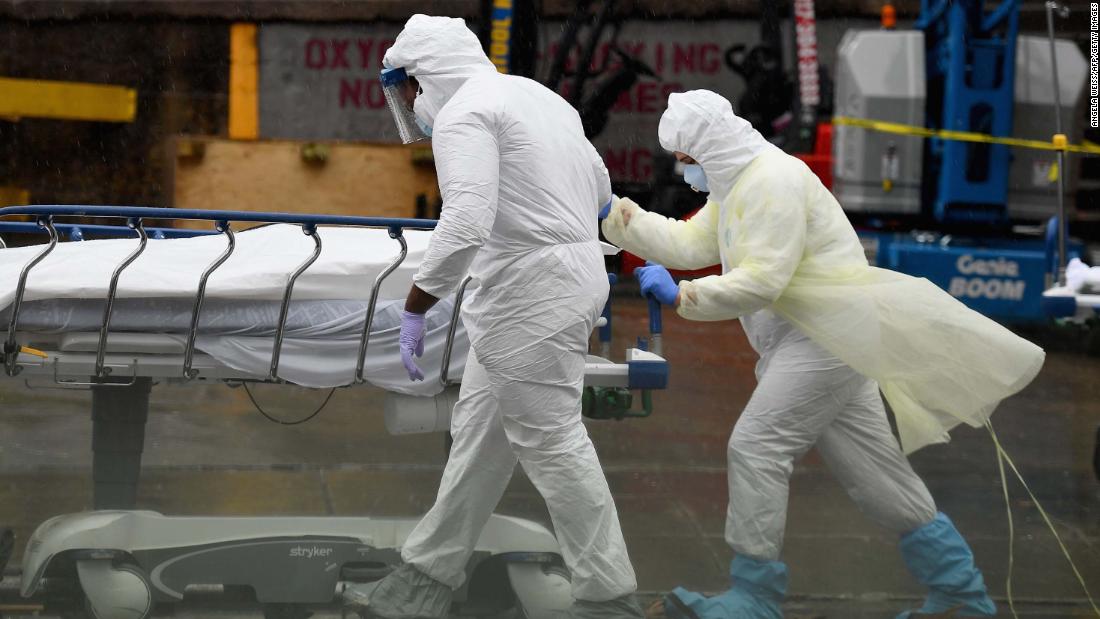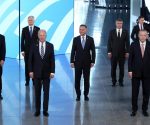They didn’t all have to die — a moment of reflection as US Covid deaths reach 100,000
[ad_1]

The desperate toll passed into six figures on Wednesday afternoon: 100,000 victims, who were living Americans several months ago, when the viciously infectious virus made landfall. The landmark is a story of lost mothers, fathers, grandparents, siblings, spouses and even children. Families are shattered, and the dying expire alone. They can’t even be mourned owing to social distancing — one of Covid-19’s cruelest impositions.
The 100,000 include Americans like 44-year-old Martin Addison, of New Jersey, the type of dad who’d do Donald Duck impressions to delight his infant son. Geraldine Slaughter of Detroit, who was in her eighties, died from Covid-19 within days of her two sisters.
But a pandemic — a signature moment alongside civil war, world wars, assassinations and economic crises, in the near 250-year history of the US — is also a political, governmental story. Politicians, few so vociferously as President Donald Trump, want the credit when things go well. So must they carry the can when they fail.
Covid-19’s assault is a once-in-a-century event, and no set of detailed plans, war games and batch of epidemiological theories could have prepared the nation for every unknown challenge.
Yet it’s also true that the US has been plagued by one of the most mismanaged, and certainly one of the most politically divisive, coronavirus mitigation efforts in the world.
In years to come, in inevitable congressional commissions and medical research, there will be plenty of blame to be shared.
Supply chains outsourced to China, Beijing’s own response to an emerging public health disaster, the World Health Organization’s missteps and loopholes created by a US federal system that often sparks power struggles in disasters will be criticized. The way state governors were slow to recognize the threat in nursing homes could turn out to be one of the most egregious mistakes.
Trump’s 2016 convention vow — “I alone can fix it” — and his entire leadership model of fomenting divisions, inventing his own facts and distracting from his failings by sparking new scandals has been irredeemably exposed. The steadily rising fatality toll brings its own awful judgments — that no number of attacks on the previous administration or raging tweets can disguise.
‘We have it totally under control’
Often, Trump has appeared far more concerned about how the crisis affected his own political prospects than those who died.
The verdict on Trump’s failure to stand up a rapid and nationwide coronavirus testing effort and his frequent and premature declarations of victory would not be so harsh had he taken the obvious approach of a pandemic more seriously.
China locked down Wuhan and Hubei province on January 23. Hong Kong, which turned into a model of how to flatten the curve, recorded its first case at the same time. The White House has disputed when and if Trump was warned by US intelligence agencies about the coming storm. But it was all over the news — and given the interconnected nature of the globalized world it was obvious that it would soon arrive in the US.
More alarm bells rang on March 8 when Italy clamped a lockdown on its Lombardy region amid a massive spike in infections.
Yet Trump spent the time between late January and announcing a “15 days to slow the spread” initiative in mid-March in denial, floating misinformation about the virus and creating an alternative reality in which it might “miraculously” disappear.
On February 25, Nancy Messonnier, the head of the US Centers for Disease Control and Prevention’s National Center for Immunization and Respiratory Diseases, infuriated the White House by warning that disruptions to daily life in the US could be “severe.”
She told schools to start thinking about closures and businesses to prepare for telecommuting in a prediction that turned out to be an entirely accurate summation of America’s destiny.
“We have had tremendous success, tremendous success, beyond what people would have thought,” Trump said the next day before launching into one of his frequent tributes to China’s President Xi Jinping, weeks before turning on China when he needed a scapegoat for his own government’s under performance.
Weeks of denial worsened the toll
In years to come, Trump’s denial in the early weeks will likely come to be seen as one of the most damaging passages of the crisis. It contributed to the disastrous deficit the US later experienced in developing a testing infrastructure — already hobbled by a failed CDC diagnostic kit — and the shortages of protective gear for emergency responders and doctors and nurses.
The megaphone given to a President is one of the most effective methods of girding a nation into action. When it is silent, that causes its own issues, as the lack of urgency shown by many states in preparing for the onslaught shows.
A Columbia University study released last week found that had the US started social distancing a week earlier, it could have prevented the loss of at least 36,000 lives.
In the New York metro area alone, 17,500 fewer people would have died if the US had acted one week earlier, Columbia epidemiologist Jeffrey Shaman said.
New York’s leaders put the blame on the Trump administration’s failure to build a robust testing system that would have shown how deeply the virus had penetrated the community.
The first months of the pandemic’s deadly path across America were dominated by fierce political arguments over deficiencies in testing needed to assess the virus’ hold on the country.
In recent weeks, with most hotspots concentrated in big, more liberal cities and urban areas, a bitter debate has unfolded about the pace of opening the shuttered economy.
Trump says that the US has “prevailed” in the pandemic and has frequently boasted that the United States now leads the world in testing — a claim not supported by the crucial, per capita metric. According to the latest data from the Covid Tracking Project, the US has now conducted 15 million tests during the pandemic. Data collected by Oxford University shows that the after a slow start, US testing is catching up. The US has now carried out 45 tests per 1,000 people, ahead of countries like Canada and the UK, but trailing states like Australia, Italy and New Zealand, which has been widely praised for its handling of the crisis.
While Trump would like to boast the world’s best Covid response, the data doesn’t bear out his claims. The US has a rate of 30 deaths per 100,000 in the population, significantly lower than hard-hit nations like Britain, France and Italy. But the US is worse off than Germany with 10 deaths per 100,000 in the population and South Korea with 0.52 deaths per 100,000, according to figures prepared by Johns Hopkins University. There is currently a mixed picture of the pandemic in the US suggesting a pivot point could be near. Currently, infections are rising in 14 states, are steady in 17 and falling in 19 states.
What’s to come
With more and more states opening up, Fauci said possible spikes in infections would not be obvious for some time.
“When you do that and you see no negative effect in one week, please don’t be overconfident,” Fauci, director of the National Institute of Allergy and Infectious Diseases, told CNN.
“Because the effect of spreading is not going to be seen for two, three and maybe even more weeks — and at that time you could have the uptick.”
Such uncertainties, as well as the current lack of a vaccine and effective Covid-19 therapies explain why it’s not clear whether the 100,000 death milestone will be the last grim and symbolic figure the US will mark.
The Institute for Health Metrics and Evaluation, or IHME, at the University of Washington has now shifted its prediction for US deaths down to 132,000 by August, amid signs that widespread wearing of masks is helping reduce infections. That figure doesn’t take into account a feared spike in the virus in the fall.
[ad_2]
Source link









